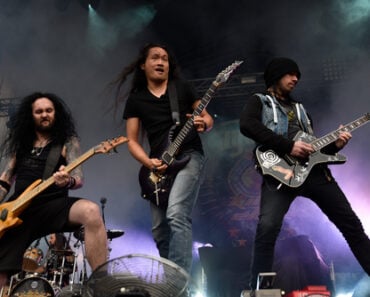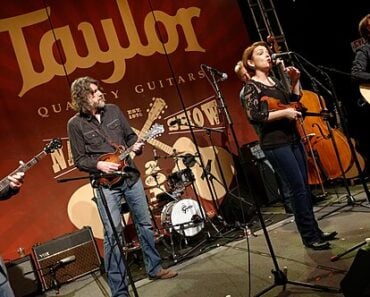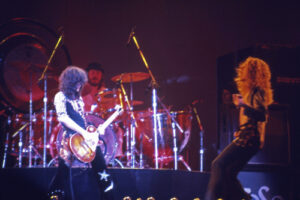
Feature Photo: A.PAES / Shutterstock.com
Living Colour blazed onto the New York music scene in 1984 when British-born guitarist Vernon Reid assembled a rotating cast of musicians under his band name. The band consists of guitarist Vernon Reid, lead vocalist Corey Glover, drummer Will Calhoun and bassist Doug Wimbish who replaced Muzz Skillings in 1992. Living Colour has released six studio albums. The band rose to fame with their debut album Vivid in 1988. Living Colour is best known for their signature song “Cult of Personality,” which won a Grammy Award for Best Hard Rock Performance in 1990 and has been consistently used as the entrance theme for professional wrestler CM Punk since 2011.
They were named Best New Artist at the 1989 MTV Video Music Awards, and won their second Grammy Award for their follow-up album Time’s Up (1990). The album reached #6 on the Billboard 200 Albums chart and was later certified double platinum by the RIAA. In 1990 the band’s second full-length album, Time’s Up, was released and reached #13 on the Billboard 200 while certifying gold. Their third album, Stain (1993), was also well received by music critics. After disbanding in 1995, Living Colour reunited in late 2000, and has since released three more studio albums: Collideøscope (2003), The Chair in the Doorway (2009) and Shade (2017).
The group underwent significant personnel changes throughout their career, particularly during their formative years from 1984 to 1986. Early band members included bassists Alex Mosely, Jerome Harris and Carl James, drummers Greg Carter, Pheeroan akLaff and J. T. Lewis, keyboardist Geri Allen, and vocalists D. K. Dyson and Mark Ledford, with Reid occasionally singing lead vocals himself. In 1986 a stable lineup was formed, consisting of vocalist/actor Corey Glover, guitarist Vernon Reid, bassist Muzz Skillings, and drummer Will Calhoun. In 1992, Skillings left the band and was replaced by Doug Wimbish. Despite retaining their strong fan base, Living Colour disbanded in January 1995 after failing to settle on common musical goals during their fourth studio album sessions.
Vernon Reid
Vernon Reid stands as the founding visionary and creative force behind Living Colour, establishing the band in 1984 and serving as its primary guitarist throughout its existence. Vernon Alphonsus Reid (born 22 August 1958) is an American guitarist and songwriter best known as the founder of the rock band Living Colour. Reid was named No. 66 on Rolling Stone magazine’s 2003 list of the 100 Greatest Guitarists of All Time, and in August 2023, was ranked No. 42 in Rolling Stone’s top 250 Greatest Guitarists of all time. Born in London to parents from Montserrat, Reid relocated to New York City as an infant and grew up immersed in the city’s diverse cultural landscape. His musical journey began well before Living Colour’s formation, gaining recognition in the avant-garde jazz scene through his work with Ronald Shannon Jackson’s Decoding Society from 1980 to 1986.
Reid’s pre-Living Colour career established him as a versatile musician comfortable crossing genre boundaries. He first came to prominence in the 1980s in Ronald Shannon Jackson’s avant-jazz-rock band The Decoding Society, and is on six studio and three live albums recorded with that group from 1980-1986. His collaborative spirit was evident early on, including a 1984 duo recording with guitarist Bill Frisell titled “Smash & Scatteration.” Beyond his musical pursuits, Reid demonstrated his commitment to social change by co-founding the Black Rock Coalition in 1985 alongside journalist Greg Tate and producer Konda Mason, an organization dedicated to promoting Black musicians in rock music.
Throughout Living Colour’s career, Reid played on all six studio albums while also handling various production duties and occasional lead vocals during the band’s earliest incarnation from 1984-1985. His guitar work has been praised for its eclectic approach that seamlessly blends heavy metal, funk, jazz, and avant-garde elements. When Living Colour disbanded in 1995, Reid continued his prolific output through numerous solo projects and collaborations, including work with artists ranging from Carlos Santana to Public Enemy. Reid composed the score for the film Paid in Full, directed by Charles Stone III and released by Miramax in the fall of 2002. He also composed scores for documentaries including “Ghosts of Attica” and “Almost Home.” Reid also appears on Guitar Oblique (Knitting Factory) with guitarists David Torn and Elliott Sharp.
Corey Glover
Corey Glover emerged as Living Colour’s distinctive voice and frontman, joining the band in 1985 and bringing both powerful vocals and acting experience to the group’s dynamic presence. Corey Cornell James Glover (born November 6, 1964) is an American singer. He is the lead vocalist of the rock band Living Colour and has toured as the vocalist for the funk band Galactic. Born in Brooklyn, Glover was pursuing an acting career when Vernon Reid discovered him, reportedly after witnessing Glover singing “Happy Birthday” at a friend’s party. This chance encounter would prove pivotal for both the aspiring actor and the nascent rock band seeking their signature sound.
Glover’s early career demonstrated his versatility as a performer, successfully balancing music and acting commitments. As an actor, he played Francis in the 1986 war movie Platoon. His role in Oliver Stone’s acclaimed Vietnam War film came at a crucial time for Living Colour, requiring him to temporarily leave the band during filming. The movie’s success, including its Academy Award for Best Picture, provided Glover with significant exposure and established his credibility as both an actor and musician. His acting pursuits continued throughout his career, including appearances in television series and hosting duties on VH1.
With Living Colour, Glover performed on all the band’s major releases from Vivid through their 1995 disbandment, then returned for their 2000 reunion and subsequent albums. His vocal contributions were integral to the band’s Grammy Award-winning performances, including their breakthrough hit “Cult of Personality.” Living Colour found immediate success with the release of their debut album, Vivid in 1988. The album’s single “Cult of Personality” won the 1989 Grammy Award for Best Hard Rock Performance and the band was named Best New Artist at the MTV Video Music Awards. Following the band’s initial breakup, Glover launched a solo career, releasing Hymns in 1998 and later The Pledge in 2012 through a crowdfunding campaign. In 2010, Glover began touring as the vocalist for the band Galactic. His theatrical background also led to significant roles in musical theater, including portraying Judas Iscariot in “Jesus Christ Superstar” from 2006 to 2010. In 2023, Billboard ranked Glover #45 on its list of 50 Greatest Rock Lead Singers of All Time.
Will Calhoun
Will Calhoun brought exceptional musical training and innovative drumming techniques to Living Colour, joining the band in 1986 and establishing himself as one of rock music’s most accomplished drummers. William Calhoun (born July 22, 1964) is an American drummer who is a member of the rock band Living Colour. Calhoun was born in the Bronx, New York. His formal musical education at Berklee College of Music provided him with a comprehensive foundation in music production and engineering, graduating with honors and receiving the prestigious Buddy Rich Jazz Masters award for outstanding performance as a drummer.
Calhoun’s pre-Living Colour experience included work with notable jazz and R&B artists, demonstrating his versatility across multiple genres. While playing with Harry Belafonte and Brooklyn musicians in college, Calhoun was introduced to Vernon Reid, the guitarist of Living Colour. In 1986, a year after he graduated from Berklee, Reid asked him to join the band as their drummer. His extensive training and diverse musical background made him an ideal fit for Living Colour’s genre-blending approach, contributing to their distinctive sound that incorporated elements of jazz, funk, and hard rock.
Throughout Living Colour’s career, Calhoun played on all their studio albums from Vivid through Shade, while also contributing as a songwriter, penning tracks including “Pride” from Time’s Up and “Nothingness” from Stain. He was voted “Best new drummer of 1988” by Modern Drummer magazine’s readers’ poll, then again as “Number one progressive drummer” three times (1989, 1991 & 1992). He was named “Best Drummer of 1990” by Rolling Stone magazine’s critics poll. His innovative drumming style incorporated advanced sampling, electronic percussion, and ethnic rhythms, making him one of the first drummers to successfully blend these elements with hard rock and metal. Beyond Living Colour, Calhoun has maintained an active career as a jazz bandleader, session musician, and educator, working with artists including Pharoah Sanders, B.B. King, Wayne Shorter, and Marcus Miller. Though best known as the drummer of the rock band Living Colour, Calhoun has also played with Jungle Funk and HeadFake, recorded jazz albums as a leader, and appeared with Pharoah Sanders, B.B. King, Herb Alpert, Dr. John, Jaco Pastorius, Wayne Shorter, Marcus Miller, Public Enemy, and Ronnie Wood.
Doug Wimbish
Doug Wimbish joined Living Colour in 1992 as the band’s second bassist, bringing extensive session experience and a pioneering background in hip-hop music to the group’s evolving sound. Douglas Arthur Wimbish (born September 22, 1956) is an American bassist, primarily known for being a member of rock band Living Colour and funk/dub/hip hop collective Tackhead, and as a session musician with artists such as Sugarhill Gang, Grandmaster Flash and the Furious Five, The Rolling Stones, Mick Jagger, Depeche Mode, James Brown, Annie Lennox, Tarja Turunen, and Barrington Levy. Born in Hartford, Connecticut, Wimbish began playing guitar at age 12 before switching to bass at 14, a decision that would shape his future as one of hip-hop’s foundational musicians.
Wimbish’s career-defining work began in 1979 when he became part of Sugarhill Records’ legendary house rhythm section alongside guitarist Skip McDonald and drummer Keith LeBlanc. In 1979 he was hired together with guitarist Skip McDonald and drummer Keith LeBlanc to form the house rhythm section for Sugarhill Records. This trio created the instrumental foundations for numerous hip-hop classics, including Grandmaster Flash and the Furious Five’s “The Message” and “White Lines,” establishing Wimbish as a pioneer in hip-hop bass playing. His session work expanded dramatically throughout the 1980s, including contributions to albums by Madonna, Jeff Beck, and Mick Jagger’s solo projects.
Wimbish’s tenure with Living Colour began when he replaced Muzz Skillings in 1992, contributing to the band’s heavier, more aggressive third album Stain and earning a Grammy nomination for the track “Leave It Alone.” Wimbish joined Living Colour in 1992 (he replaced Muzz Skillings, who left the band) to tour and record the album, Stain. When Living Colour disbanded in 1995, Wimbish returned to London to continue his session work and formed various collaborative projects. He was instrumental in the band’s 2000 reunion, with the initial reunion show featuring his drum and bass project Head>>Fake with Will Calhoun. Together with Tackhead and as a session bassist, Wimbish found himself in demand as a bass player for many artists and was considered as a permanent sideman for the Rolling Stones after the departure of bassist Bill Wyman in 1993, but lost the position to Darryl Jones. Throughout Living Colour’s reunion period, Wimbish contributed to Collideøscope (2003), The Chair in the Doorway (2009), and Shade (2017), while maintaining his reputation as one of the most sought-after session bassists in contemporary music.
Muzz Skillings
Muzz Skillings served as Living Colour’s original bassist from the band’s stable lineup formation in 1986 until his departure in 1992, contributing to their most commercially successful and critically acclaimed period. Muzz Skillings (born January 6, 1960, in Queens, New York) is an American bassist, singer, guitarist and songwriter. He is best known for having been the original bassist with Living Colour. Skillings joined the band during their formative period and became integral to their breakthrough success, performing on their Grammy Award-winning debut Vivid and the equally successful follow-up Time’s Up.
Skillings’ bass playing style became synonymous with Living Colour’s early sound, featuring complex melodic lines that complemented the band’s fusion of rock, funk, and jazz elements. Skillings played bass, sang backing vocals, and co-wrote songs on the Grammy award-winning 1988 debut album Vivid, the Grammy award-winning 1990 follow up Time’s Up, and the 1991 EP Biscuits. His technical proficiency and creative approach to the bass guitar earned him widespread recognition among musicians and critics. His use of melodic, complex and moving bass lines during his time with Living Colour left him with high acclaim from musicians worldwide.
The bassist’s departure from Living Colour in 1992 marked the end of the band’s original lineup and their most commercially successful era. Skillings’s departure from the band in 1992 was due to musical differences and a desire to branch off and evolve musically outside of Living Colour. Despite leaving the band, Skillings maintained positive relationships with his former bandmates. He left under good terms (as indicated in his liner notes printed in the album sleeve of Living Colour’s 1995 best-of compilation, Pride) and has returned to the band on occasion (for one-off events) in order to cover for their current bassist Doug Wimbish when the latter is unavailable. On September 22, 2006, Skillings joined the band for the first time in fourteen years when they played at a private party that drummer Jack DeJohnette threw for his wife, Lydia. Following his departure from Living Colour, Skillings pursued various musical projects while maintaining a relatively low public profile compared to his former bandmates.
Alex Mosely
Alex Mosely was among Living Colour’s earliest bassists during the band’s formative period from 1984 to 1986, when Vernon Reid was assembling different lineups under the Living Colour name. Early band members included bassists Alex Mosely, Jerome Harris and Carl James, drummers Greg Carter, Pheeroan akLaff and J. T. Lewis, keyboardist Geri Allen, and vocalists D. K. Dyson and Mark Ledford, with Reid occasionally singing lead vocals himself. Mosely contributed to the band during its experimental jazz-funk period, when their sound differed significantly from their later major-label recordings. His tenure with the group occurred before they achieved their stable lineup in 1986 and predated their commercial breakthrough with Vivid. Limited information is available about Mosely’s specific contributions to Living Colour’s early material or his subsequent musical career after leaving the band.
Jerome Harris
Jerome Harris served as one of Living Colour’s rotating bassists during their early developmental years between 1984 and 1986. Early band members included bassists Alex Mosely, Jerome Harris and Carl James, drummers Greg Carter, Pheeroan akLaff and J. T. Lewis, keyboardist Geri Allen, and vocalists D. K. Dyson and Mark Ledford, with Reid occasionally singing lead vocals himself. During this period, the band’s musical direction was markedly different from their later recordings, featuring more jazz and experimental elements. Harris was part of Vernon Reid’s evolving vision for the band before they solidified their commercially successful lineup. His contributions occurred during a time when Living Colour was exploring various musical territories, including instrumental jazz-funk workouts and experimental compositions. Details about Harris’s specific role in the band’s compositions or his career following his departure from Living Colour are not widely documented.
Carl James
Carl James was another bassist who participated in Living Colour’s rotating lineup during the band’s early formation period from 1984 to 1986. Early band members included bassists Alex Mosely, Jerome Harris and Carl James, drummers Greg Carter, Pheeroan akLaff and J. T. Lewis, keyboardist Geri Allen, and vocalists D. K. Dyson and Mark Ledford, with Reid occasionally singing lead vocals himself. James worked with Vernon Reid during the experimental phase of the band’s development, contributing to material that included jazz-funk instrumentals and politically charged compositions. His involvement predated the formation of Living Colour’s stable and commercially successful lineup that would emerge in 1986. The band’s sound was vastly different from the songs later in their significant label recordings. Information about James’s specific musical contributions during his time with the band or his subsequent career remains limited in available sources.
Greg Carter
Greg Carter served as one of the drummers during Living Colour’s formative years, contributing to the band’s sound during their experimental period from 1984 to 1986. Early band members included bassists Alex Mosely, Jerome Harris and Carl James, drummers Greg Carter, Pheeroan akLaff and J. T. Lewis, keyboardist Geri Allen, and vocalists D. K. Dyson and Mark Ledford, with Reid occasionally singing lead vocals himself. Carter was part of Vernon Reid’s evolving vision for Living Colour before they established their definitive lineup. During this period, the band explored diverse musical territories that differed significantly from their later major-label success. Carter’s drumming contributed to material that ranged from instrumental jazz-funk pieces to experimental rock compositions. His tenure ended before the band’s commercial breakthrough, and specific details about his contributions to recordings or his career after leaving Living Colour are not extensively documented in available sources.
Pheeroan akLaff
Pheeroan akLaff was among the drummers who worked with Living Colour during their early developmental phase between 1984 and 1986, before the band achieved their stable lineup. Early band members included bassists Alex Mosely, Jerome Harris and Carl James, drummers Greg Carter, Pheeroan akLaff and J. T. Lewis, keyboardist Geri Allen, and vocalists D. K. Dyson and Mark Ledford, with Reid occasionally singing lead vocals himself. akLaff contributed to the band during a period when Vernon Reid was experimenting with various musical directions and personnel configurations. The material from this era included jazz-influenced compositions and experimental works that showcased a different musical approach than Living Colour’s later commercial releases. akLaff’s involvement preceded the formation of the band’s breakthrough lineup and their subsequent major-label success. Limited information is available regarding his specific contributions to recordings or his musical career following his departure from Living Colour.
J.T. Lewis
J.T. Lewis was one of the drummers who participated in Living Colour’s rotating lineup during the band’s formative period from 1984 to 1986. Early band members included bassists Alex Mosely, Jerome Harris and Carl James, drummers Greg Carter, Pheeroan akLaff and J. T. Lewis, keyboardist Geri Allen, and vocalists D. K. Dyson and Mark Ledford, with Reid occasionally singing lead vocals himself. Lewis worked with Vernon Reid during the experimental phase of the band’s development, contributing to material that was markedly different from their later commercial recordings. His drumming was part of Living Colour’s exploration of various musical styles, including jazz-funk instrumentals and avant-garde compositions. Lewis’s tenure with the band concluded before they established their stable 1986 lineup that would lead to their breakthrough success. Information about his specific contributions to the band’s early material or his subsequent musical endeavors remains limited in available documentation.
Geri Allen
Geri Allen served as keyboardist during Living Colour’s early experimental period from 1984 to 1986, bringing her accomplished jazz background to the band’s evolving sound. Early band members included bassists Alex Mosely, Jerome Harris and Carl James, drummers Greg Carter, Pheeroan akLaff and J. T. Lewis, keyboardist Geri Allen, and vocalists D. K. Dyson and Mark Ledford, with Reid occasionally singing lead vocals himself. Allen was a respected jazz pianist and composer who brought significant musical credibility to Vernon Reid’s project during its developmental phase. Her keyboard work contributed to the band’s jazz-fusion oriented material that characterized their early sound, which differed substantially from their later hard rock direction. Allen’s involvement with Living Colour represented one chapter in her distinguished career as a jazz artist. Tragically, Allen passed away in 2017, leaving behind a legacy as one of jazz’s most innovative pianists. Her brief but notable contribution to Living Colour’s formation demonstrates the diverse musical backgrounds that Reid drew upon while developing the band’s unique sound.
D.K. Dyson
D.K. Dyson was one of the vocalists who worked with Living Colour during their early formation period between 1984 and 1986, before Corey Glover joined as the band’s permanent lead singer. Early band members included bassists Alex Mosely, Jerome Harris and Carl James, drummers Greg Carter, Pheeroan akLaff and J. T. Lewis, keyboardist Geri Allen, and vocalists D. K. Dyson and Mark Ledford, with Reid occasionally singing lead vocals himself. Dyson contributed vocals during Living Colour’s experimental period, when the band was exploring different musical directions and lineup configurations under Vernon Reid’s leadership. The material from this era featured a more diverse sound palette than their later commercial releases, including jazz-fusion elements and politically charged compositions. Dyson’s vocal work preceded the establishment of the band’s stable lineup in 1986 and their subsequent breakthrough success. Details about Dyson’s specific contributions to recordings or their musical career following their departure from Living Colour are not extensively documented in available sources.
Mark Ledford
Mark Ledford served as one of Living Colour’s early vocalists during their formative years from 1984 to 1986, contributing to the band before Corey Glover became their permanent frontman. Early band members included bassists Alex Mosely, Jerome Harris and Carl James, drummers Greg Carter, Pheeroan akLaff and J. T. Lewis, keyboardist Geri Allen, and vocalists D. K. Dyson and Mark Ledford, with Reid occasionally singing lead vocals himself. Ledford notably fronted the band during a significant early performance at the Moers Jazz Festival in Europe in 1986, when Corey Glover was temporarily away from the group to film his role in Platoon. This appearance represented an important step in Living Colour’s international exposure during their developmental period. Ledford’s vocal contributions occurred during the band’s experimental phase, when they were exploring jazz-fusion and avant-garde musical territories that differed from their later commercial sound. Sadly, Mark Ledford passed away in 2004, cutting short what had been a promising musical career. His brief but notable involvement with Living Colour during their crucial formative period demonstrates the various talents that Vernon Reid incorporated while developing the band’s distinctive sound and direction.
Doug Pinnick
Doug Pinnick served as a substitute lead vocalist for Living Colour in 2006, filling in during a specific performance when Corey Glover was unavailable. Pinnick, best known as the bassist and vocalist for the progressive rock band King’s X, stepped into the frontman role for this one-off appearance, demonstrating the respect and connections Living Colour maintained within the rock music community. His involvement with the band was brief but significant, representing the mutual admiration between accomplished musicians across different bands and genres. Pinnick’s distinctive vocal style, honed through decades with King’s X, provided an interesting interpretation of Living Colour’s material during his guest appearance. This substitution highlighted the collaborative spirit that has characterized Living Colour’s approach to music-making throughout their career, as well as their ability to adapt and continue performing even when core members face scheduling conflicts.
Check out more Living Colour articles on ClassicRockHistory.com Just click on any of the links below……
Corey Glover of Living Colour: The ClassicRockHistory.com Interview
Top 10 Living Colour Songs
Read More: Artists’ Interviews Directory At ClassicRockHistory.com
Read More: Classic Rock Bands List And Directory



































